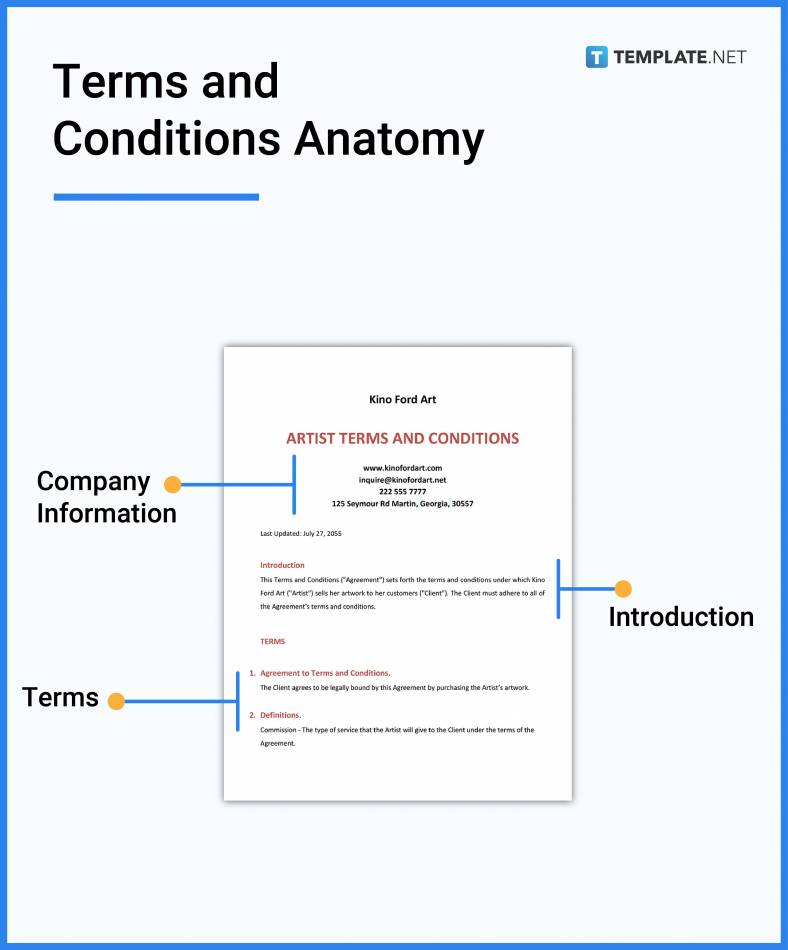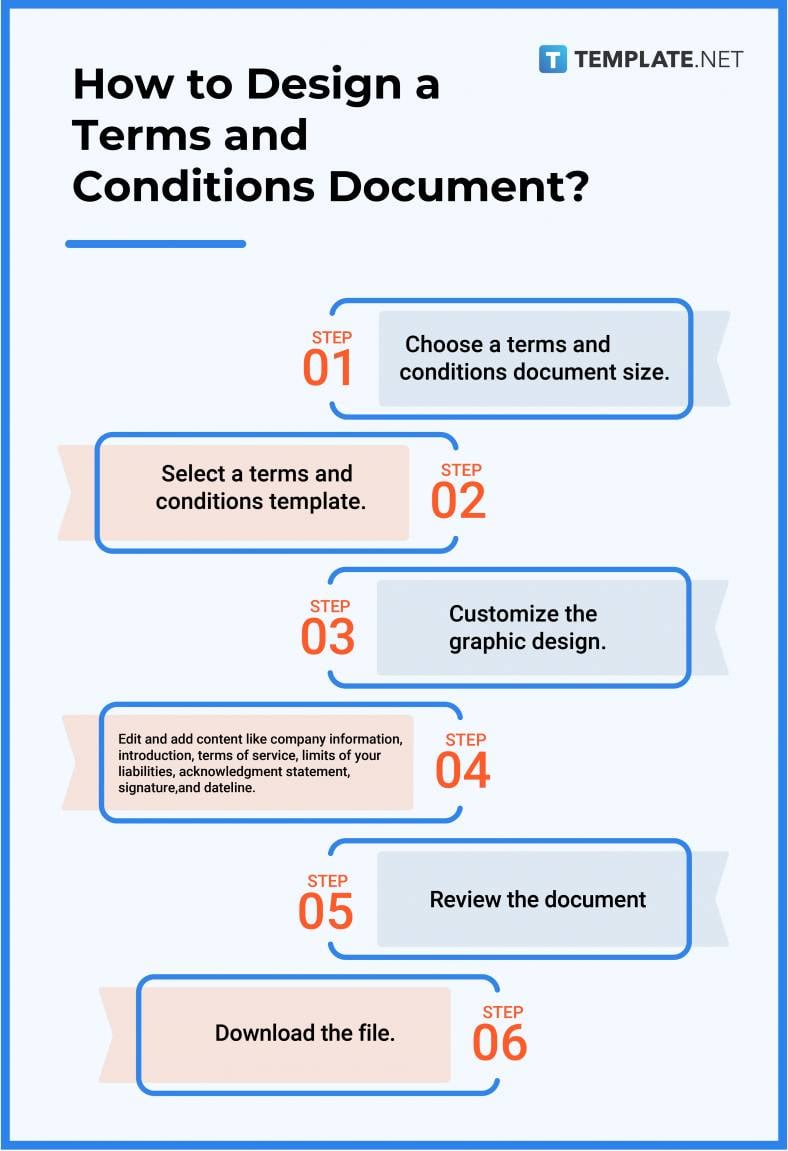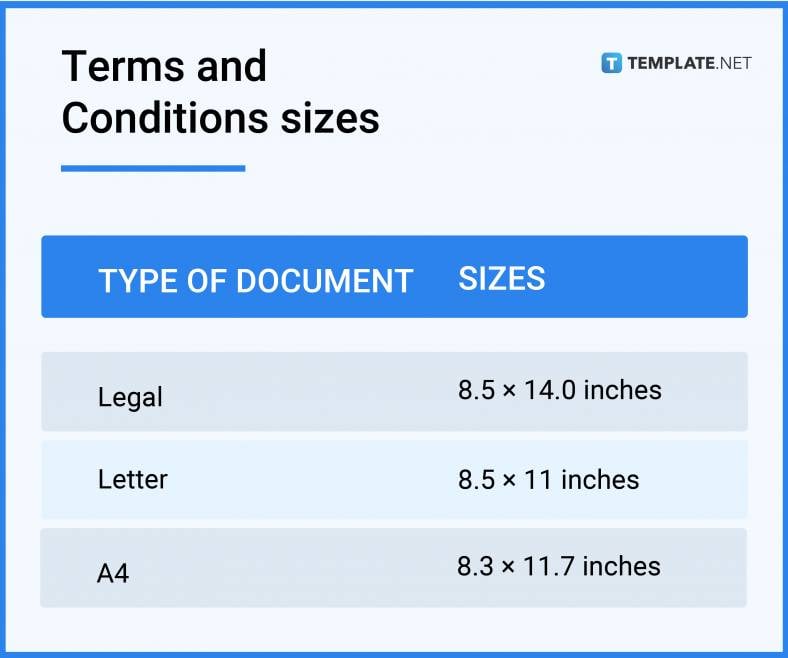![How To Create Meeting Minutes in Google Docs [Template + Example]](https://images.template.net/wp-content/uploads/2023/07/How-To-Make_Create-Meeting-Minutes-in-Google-Docs-Template-Example-788x443.png)
How To Create Meeting Minutes in Google Docs [Template + Example]
Meeting minutes Play a vital role in the recording of meeting information and details. In any kind of meeting, there is always…
Apr 22, 2023
When trying to operate a business, there are always a million other things to do except worry about the fine print. To minimize any confusion regarding the goods or services being sold and the terms under which they are being sold, it is imperative that all businesses, whether new or well-established, have clear and comprehensive terms and conditions.

Terms and conditions, often known as a service’s “Terms of Service” (ToS), “Terms of Use,” or “End-User License Agreement,” is a document that outlines the legal obligations of both the service’s supplier and its user.
This means that a terms and conditions agreement is the agreement that includes the terms, the regulations and the guidelines of acceptable conduct, and other relevant parts to which users must agree to use or access your website and mobile app.
When you offer goods and services on an online platform, you want to make sure the agreement between you and your customer or user is clear to avoid conflicts and disputes. A terms and conditions agreement explains the website administrator’s regulations for user conduct and gives information about the activities the website administrator may and will conduct. Generally speaking, your terms and conditions article is a contract between your website and its users.
An organization’s need for terms and conditions contract is universal, regardless of whether the organization sells goods or services. It safeguards your company, spells out your practices, caps your legal exposure, and lays out the terms of your agreement. Depending on the nature of your business, additional provisions may be necessary in your terms and conditions, as in the example below.
Companies make contractual agreements and negotiate with investors and business suppliers almost daily. Therefore, as an owner, you want your rights to be protected and prevent conflicts and disputes by ensuring guidelines and policies to your agreements are laid out precisely. See this example below to learn how to generate a company terms and conditions.
A T&C agreement is an excellent solution for any website, whether it is an e-commerce platform or simply provides a user account system. Your website’s Terms and Conditions will lay out disclaimers that can protect your business from problems beyond your control. Here’s an example of editable e-commerce terms and conditions for your website.
Products with warranties are guaranteed to be of high quality and free from faults in materials and workmanship. A consumer who purchases a product with a warranty has the legal right to request that the manufacturer resolve any problems in accordance with the warranty’s terms and conditions. Download this template below to see how warranty terms and conditions are drafted.
Voucher terms and conditions usually indicate the restrictions on the use and conversion. Most gift vouchers are non-refundable and cannot be converted to cash. This template below shows typical stipulations for vouchers.
Terms and conditions also apply when you make a booking with either a travel agency’s consultant or via their website. It usually outlines cancellation, refund, rescheduling, reservation policies, etc. To understand more, here’s an example of a travel agency terms and conditions.
Sponsorship occurs when a business offers financial or in-kind support to a charitable organization’s event or program in exchange for public relations advantages. Banners and wearable stuff, like T-shirts, for example, can feature a company’s branding in exchange for financial support. Get a good look at what sponsorship terms and conditions look like and download this template below.
Regardless of size, your business will need terms and conditions to set out guidelines for your customers when purchasing your product. This document is as important as your sales invoice for every purchase order. Download this example below and start drafting your small business terms and conditions.
Restaurants cannot run their food business without a good relationship with suppliers. T&Cs s are basically the documents that represent that relationship as they lay out the agreements of the restaurant owner and the suppliers. For context, here’s a free downloadable restaurant purchase terms and conditions template.
A quotation is a written estimate of the price for a certain service or product. Terms and Conditions for quotations usually show policies and regulations on purchase orders, prices, taxes, packaging, shipping, and delivery. Here’s a free customizable quotation terms and conditions template you can download for your business needs.
We all know that terms and conditions are the little print we don’t read. However, terms and conditions play an essential role in the day-to-day operations of organizations and institutions. Whether for business or non-profit, a company opens itself up to legal risk without properly drafted terms and conditions, and the following are the reasons why.
You can outline penalties for late payments from your customers in the contents of your stipulations. You can also establish other parameters for your regulations, such as a minimum purchase requirement to qualify for a discount, how billings are made, and what happens if payments need to be returned.
When you operate a business, you almost always create intellectual property. Examples include things like copyrighted or registered materials, as well as things like recipes and plans. A contract between you and other users of your online shop, business software, or mobile application, outlining what is copyrighted is the first step in protecting your intellectual property.
Arguably the most important reason why terms and conditions are in place is to protect both parties in the event of non-compliance by either the customer or the vendor. In the event of a violation of the terms and conditions, you are entitled to legal recourse.
If your products have serious flaws, for instance, consumers should be able to return them for a refund. It’s up to you whether you want to go the extra mile and let customers return things they purchased within 30 days, even if they’re satisfied with them, so long as you clearly outline the details of the parameters.
Your terms and conditions document should contain your company’s information like the name, website, email, and phone number.
It would be best if you started with an introductory statement that clearly describes the document and what the user can expect to read from it.
This is where you will outline all important information like policies, registration restrictions, disclaimer of liabilities, general statutory rules and regulations, and when your subscription will be subject to renewal or revocation.

1. Choose a terms and conditions document size.
2. Select a terms and conditions template.
3. Customize the graphic design.
4. Edit and add content like company information, introduction, terms of service, limits of your liabilities, acknowledgment statement, signature, and dateline.
5. Review the document
6. Download the file.

A terms and conditions agreement is in place for your safety as a business.
A privacy policy is in place to benefit your clients or safeguard your customers and users.
Terms and Conditions are general rules and regulations for being able to enjoy the use of a service or product like a website or a software application.
Contracts are more formal and enforceable legal documents that are used in almost every transaction and it contains terms and conditions as well as agreements of both parties.
Agreements are less formal as they can merely be just verbal concurrence between two parties.
It’s possible to find many different forms of terms and condition sizes templates but the following are some of the most typical dimensions:

Drafting your terms and conditions can be hard because the content and format depend on its purpose. You can take a look at some of our examples below so you can grab ideas on how to draft your terms and conditions.
Your terms should include policies, registration restrictions, disclaimer of liabilities, general statutory rules and regulations, intellectual property rights, payment terms, and advertising endorsements.
It means that the terms and conditions indicated by the marketer or the website’s administrator apply when using the product or enjoying the service.
When the user is given clear and conspicuous information about the nature of the commitment being made, the terms of service become legally obligatory.
The copyright conditions, age restrictions, and controlling law of the contract are just a few examples of the types of restrictions that can be included in the terms and conditions that a business can use to manage the usage of their product or service.
Generally, the main purpose of purchase order terms and conditions is to outline the agreements between the buyer and the seller.
When drafting terms and conditions, you can start with ensuring your information and an introductory statement are written and then outline your terms of service as clearly as possible.
A basic T&C contains an introduction, terms of service, acknowledgment statement, and disclaimer of liabilities.
They help the parties to the agreement understand their respective legal rights and responsibilities and set forth the primary business terms you are offering your customers.
An acknowledgment statement should be written at the end of the T&C for end-users to indicate their acceptance of the contract.
In order to legally interact with clients, you must have a set of standard (written) terms and conditions (T&Cs) in place from the get-go.
Most common agreements in terms and conditions for real estate include Covers such items as financing, seller contributions, home inspection, fixtures and appliances, closing date, sale of the existing home, etc.
![How To Create Meeting Minutes in Google Docs [Template + Example]](https://images.template.net/wp-content/uploads/2023/07/How-To-Make_Create-Meeting-Minutes-in-Google-Docs-Template-Example-788x443.png)
Meeting minutes Play a vital role in the recording of meeting information and details. In any kind of meeting, there is always…
![How To Make/Create a Manual in Google Docs [Templates + Examples] 2023](https://images.template.net/wp-content/uploads/2023/07/How-To-Make-Create-a-Manual-in-Google-Docs-788x443.png)
Manuals are essential instructional and reference guides. They help direct and inform an individual’s actions and also explain how to…
![How To Make/Create a Manual in Microsoft Word [Templates + Examples] 2023](https://images.template.net/wp-content/uploads/2023/07/How-To-Make-Create-a-Manual-in-Microsoft-Word-788x443.png)
Creating a manual can be a time-consuming and tedious task. However, manuals and other reference guides are necessary for organizations…
![How To Create a Legal Document in Google Docs [Template + Example]](https://images.template.net/wp-content/uploads/2023/07/How-To-Make_Create-a-Legal-Document-in-Google-Docs-Template-Example-2023-788x443.png)
When creating a legal document, there are a lot of things a person has to consider, and one of which is the…
![How To Make/Create a Contract in Microsoft Word [Template + Example] 2023](https://images.template.net/wp-content/uploads/2023/07/How-To-Make_Create-a-Contract-in-Microsoft-Word-Template-Example-2023-1-788x443.png)
Contracts can come in different forms and for different reasons but the most common thing is that when a company does business with…
![How To Create a Contract in Google Docs [Template + Example]](https://images.template.net/wp-content/uploads/2023/07/How-To-Make_Create-a-Contract-in-Google-Docs-Template-Example-2023-Step-788x443.png)
Contracts are an important part of any company or business, especially those that work with different companies or businesses. Companies…
![How To Make/Create a Report in Google Docs [Templates + Examples] 2023](https://images.template.net/wp-content/uploads/2023/07/How-To-Create-a-Report-in-Microsoft-Word-788x443.png)
A report is a comprehensive document that covers a wide array of topics from finance, research, incidents, feasibility studies, and…
![How To Make/Create a Report in Microsoft Word [Templates + Examples] 2023](https://images.template.net/wp-content/uploads/2023/07/How-To-Make_Create-a-Report-in-Microsoft-Word-Templates-Examples-20232-788x443.png)
A report is a document that contains information, data, analysis, finding, and other relevant information based on a specific topic.…
![How to Make/Create a Notebook in Google Docs [Templates + Examples] 2023](https://images.template.net/wp-content/uploads/2023/07/How-to-Make_Create-a-Notebook-in-Google-Docs-Templates-Examples-2023-788x443.png)
Notebooks always come in handy in writing important information or expressing our thoughts through written words. When we need a…